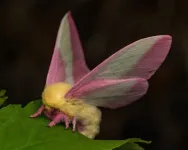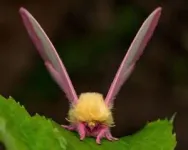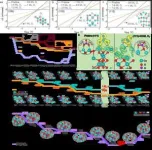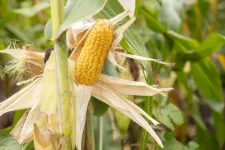(Press-News.org) How does one species become two? If you’re a biologist, that’s a loaded question. The consensus is that, in most cases, the process of speciation occurs when individuals from a single population become geographically isolated. If they remain separate long enough, they lose the ability to interbreed.
A new study published in the journal Proceedings of the Royal Society B: Biological Sciences demonstrates what happens when a less common form of speciation occurs. Rather than being separated by a physical barrier, such as a mountain range or an ocean, members of a species can become separated in time.
The researchers focused on two closely related moth species with overlapping ranges in the southeastern United States.
“These two are very similar,” said lead author Yash Sondhi, who conducted research for the study while working at Florida International University and later at the Florida Museum of Natural History. “They’ve differentiated along this one axis, which is when they fly.”
Rosy maple moths, in the genus Dryocampa, look like what you’d get if Roald Dahl painted something from a fever dream. They bear a thick lion’s mane above their head and abdomen, and their vibrant scales are the color of strawberry and banana taffy. Both male and female rosy moths fly exclusively at night.
Pink-striped oakworm moths, in the genus Anisota, are less flashy, with subtle grades of ochre, umber and marl. While females of this species are active at dusk and early evening, the males prefer to fly during the day.
Sondhi knew from previous research that these two groups, Dryocampa and Anisota, originated from a single species approximately 3.8 million years ago, which is relatively recent on evolutionary time scales. There’s a handful of species in the genus Anisota, all of which are active during the day. The nocturnal rosy maple moths are the only species in the genus Dryocampa.
Sondhi specializes in the biology of insect vision and saw the moth pair as the perfect opportunity to explore how vision evolves when a species switches up its pattern of activity.
But things didn’t go as planned.
“I went in looking for differences in color vision. Instead, we found differences in their clock genes, which in hindsight makes sense,” Sondhi said.
Clock genes control the circadian rhythm of plants and animals. The ebb and flow of the proteins they create causes cells to become either active or dormant over a period of roughly 24 hours. They affect everything from metabolism and cell growth to blood pressure and body temperature.
For any organism reversing its pattern of activity, clock genes are virtually guaranteed to be involved. “It’s a system that’s been retained in everything from fruit flies to mammals and plants. They all have some kind of time-keeping mechanism,” he said.
Sondhi compared the transcriptomes of the two moths. Unlike genomes, which contain the entirety of an organism’s DNA, transcriptomes contain only the subset of genetic material that is being actively used to make proteins. This makes them useful for exploring differences in protein levels throughout the day.
As expected, Sondhi found a number of genes that were expressed in different quantities in the two moth species. Nocturnal rosy maple moths invested more energy in their sense of smell, whereas the day-flying oakworm moth produced more genes associated with vision.
There were, however, no differences in the genes that confer the ability to see color. That doesn’t necessarily mean that their color vision is identical, but if differences do exist, they are likely at the level of tuning and sensitivity and not in the structure of the genes themselves.
There was an additional gene that stood out. Disconnected, or disco, was expressed at different levels during the day and night in both species. In fruit flies, disco is known to indirectly influence circadian rhythms through the production of neurons that transmit clock enzymes from the brain to the body.
The disco gene Sondhi found in his moth samples was twice the size of its fruit fly counterpart, and it had additional zinc fingers — active portions of a gene that directly interacts with DNA, RNA and proteins. It seemed likely that changes in the disco gene were at least partially responsible for the switch to night-flying in rosy maple moths.
When he compared the disco gene of rosy maple moths with the one in oakworms, he found 23 mutations that made each distinct from the other. The mutations were also located in active portions of the gene, meaning they likely contribute to observable physical differences between the moths. Sondhi was looking at evolution in action.
“If this is functionally confirmed, this is a really concrete example of the mechanism behind how they speciated at the molecular level, which is rare to come by,” he said.
The study is also an important push for a better understanding of the various ways in which life sustains and propagates itself. When genetics first became a field of study, researchers focused most their efforts on a few representative species, such as fruit flies or lab mice. This was done primarily for the sake of expediency, but it limits how much we know about broad biological patterns. Just as a human is not a lab mouse, a moth is not a fruit fly.
“As species continue to decline due to climate change and other anthropogenic changes, we’ll need to genetically engineer a greater number of the ones that remain to enable drought tolerance, for example, or to be active in light polluted regimes. To do that consistently, having a broader pool of functionally characterized genes across organisms is crucial. We can’t just use Drosophila,” Sondhi said.
-30-
The Florida Museum of Natural History has been inspiring people to value and protect the biological richness and cultural heritage of our diverse world for more than a century. Located on the University of Florida campus, the Florida Museum is home to more than 40 million specimens and artifacts, one of the nation’s largest natural history collections. For more Florida Museum research and collections news, visit www.floridamuseum.ufl.edu/science/ or follow us on social media, @FloridaMuseum.
-###-
END
UVDF Funding, Henna
Henna Secures $30,000 from PSU’s University Venture Development Fund to Enhance AI Fairness & Safety
Portland, OR – August 13, 2024 – Henna, a startup with deep ties to Portland State University (PSU), has successfully secured $30,000 in funding from the University Venture Development Fund (UVDF). This grant will support Henna's mission to make AI adoption fairer and safer.
Henna was founded earlier this year by Arsh Haque (they/them), Chair of the Diversity, Equity, & Inclusion ...
Work has started on a new Quantum Communications Hub Optical Ground Station (HOGS), a state-of-the-art telescope which is being built on Heriot-Watt University’s Research Park.
The new facility will demonstrate and test satellite quantum secure communications, maintaining and growing the UK’s strength in the field of quantum technologies. It is scheduled to be fully operational by late Autumn [2024].
As well as helping to tackle future cyberattacks by researching methods to send secure transmissions via satellites, it will unlock new research on space environmentalism alongside innovative R&D activities for future laser communication ...
New York, NY – The State University of New York Board of Trustees today appointed Dr. David Troilo as president of SUNY College of Optometry. He is the 4th president to serve the state’s only college of optometry, following the retirement of Dr. David A. Heath after 17 years of dedicated service to the campus. Dr. Troilo’s appointment is effective immediately.
The SUNY Board of Trustees said, “SUNY College of Optometry is a center of research and academic excellence, and Dr. Troilo is a collaborative and thoughtful leader who is ready to move the campus forward growing ...
A new applied mathematical theory could enhance our understanding of how sea ice affects global climate, potentially improving the accuracy of climate predictions.
The authors of a new paper published in the Proceedings of the Royal Society A on 28 August, offer new insights into how heat travels through sea ice, a crucial factor in regulating Earth's polar climate.
Dr Noa Kraitzman, Senior Lecturer in Applied Mathematics at Macquarie University and lead author of the study, says the research addresses a key gap in current climate modelling.
“Sea ice covers about 15 per cent of the ocean’s surface during ...
Individuals with type 2 diabetes who are at higher risk of certain cancers could be identified by a simple blood test, this year’s Annual Meeting of the European Association for the Study of Diabetes (EASD) (Madrid, 9-13 September) will hear.
People with type 2 diabetes are known to be at higher risk of developing cancers associated with obesity (OR cancers), including breast, kidney, womb, thyroid and ovarian cancer, as well as gastrointestinal cancers, including colorectal and pancreatic ...
The University of Texas School of Public Health San Antonio (UT School of Public Health San Antonio), a collaboration between The University of Texas Health Science Center at San Antonio (UT Health San Antonio) and The University of Texas at San Antonio (UTSA), proudly welcomes its inaugural class and the official launch of the region’s first Master of Public Health (MPH) graduate degree program.
Beginning Monday, Aug. 26, the first cohort of 40 students will attended classes at the new UT School of Public Health San Antonio, located on the Greehey Campus at UT Health San Antonio. Many of the students in the program ...
COLUMBIA, Mo. -- Even before the coronavirus pandemic, high rates of burnout and staffing shortages plagued the nursing industry, primarily because of the stressful demands of the job. The COVID-19 pandemic only amplified these challenges, and with nearly a third of all Missouri nurses nearing retirement, improving nurse retention is key to avoiding an impending nursing workforce crisis in our state.
Despite dozens of studies proving burnout is an issue, few provide interventions to help nurses — and their patients — overcome its challenges.
A recent study by the University of Missouri has found that ...
The Cascadia subduction zone in the Pacific Northwest has a history of producing powerful and destructive earthquakes that have sunk forests and spawned tsunamis that reached all the way to the shores of Japan.
The most recent great earthquake was in 1700. But it probably won’t be the last. And the area that stands to be affected is now bustling metropolises that are home to millions of people.
Figuring out the frequency of earthquakes – and when the next “big one” will happen – is an active scientific question that involves looking for signs of past earthquakes in the geologic record in the form of shaken up rocks, ...
With the Paris 2024 Paralympic Games just around the corner, the extensive training and the sacrifices athletes make to compete at the games take centre stage.
For Paralympians and high-performance athletes with spinal cord injuries (SCI), assessing chronic pain plays a key role in their training and readiness to compete. However, the source of chronic pain is often misattributed to acute trauma or overuse injuries. While the International Olympic Committee acknowledges pain management data among Paralympians and athletes with disabilities is limited, few studies have been launched investigating this dilemma.
Now, new research from UBC Okanagan highlights the need for more comprehensive ...
URBANA, Ill. – In the agricultural and food industry, determining the chemical composition of raw materials is important for production efficiency, application, and price. Traditional laboratory testing is time-consuming, complicated, and expensive. New research from the University of Illinois Urbana-Champaign demonstrates that near-infrared (NIR) spectroscopy and machine learning can provide quick, accurate, and cost-effective product analysis.
In two studies, the researchers explore the use of NIR spectroscopy for analyzing characteristics of corn kernels and sorghum biomass.
“NIR spectroscopy has many advantages over traditional methods. ...








